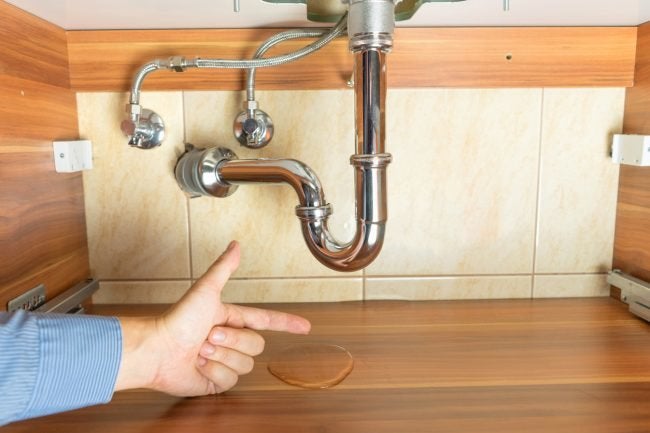Just how to Inspect If Your House Has a Covert Leak
Apply NowThe article following next involving Leaking water lines is relatively enjoyable. Don't overlook it.

Early detection of dripping water lines can minimize a possible calamity. Some little water leakages may not be visible.
1. Examine the Water Meter
Every residence has a water meter. Inspecting it is a guaranteed way that helps you uncover leaks. For beginners, shut off all the water sources. Make certain nobody will purge, utilize the tap, shower, run the washing equipment or dishwashing machine. From there, go to the meter as well as watch if it will alter. Since nobody is utilizing it, there ought to be no activities. That suggests a fast-moving leakage if it moves. If you find no changes, wait an hour or two as well as inspect back again. This implies you may have a sluggish leak that might even be underground.
2. Inspect Water Intake
Examine your water costs and track your water consumption. As the one paying it, you must see if there are any inconsistencies. If you identify sudden changes, regardless of your intake coinciding, it implies that you have leaks in your plumbing system. Keep in mind, your water expense should fall under the same range every month. An unexpected spike in your bill shows a fast-moving leak.
A consistent boost every month, also with the very same behaviors, reveals you have a slow-moving leakage that's additionally gradually intensifying. Call a plumber to completely check your building, specifically if you really feel a cozy area on your floor with piping below.
3. Do a Food Coloring Examination
When it involves water intake, 30% comes from toilets. Test to see if they are running properly. Decline specks of food shade in the storage tank and wait 10 mins. There's a leakage between the container and dish if the color somehow infiltrates your dish during that time without flushing.
4. Asses Outside Lines
Do not neglect to check your outside water lines as well. Examination faucets by attaching a garden hose pipe. Must water seep out of the link, you have a loosened rubber gasket. Replace this and also make certain all links are limited. It will certainly aid obtain it skillfully analyzed and maintained each year if you have actually got a sprinkler system. One little leakage can squander tons of water and also surge your water bill.
5. Analyze the circumstance and also inspect
Home owners should make it a routine to examine under the sink counters and even inside cupboards for any kind of bad odor or mold growth. These two red flags suggest a leakage so punctual attention is required. Doing routine assessments, also bi-annually, can conserve you from a significant trouble.
Examine for discolorations as well as damaging as most home appliances and pipes have a life span. If you suspect dripping water lines in your plumbing system, do not wait for it to rise.
Early detection of dripping water lines can reduce a potential disaster. Some little water leaks might not be visible. Checking it is a proven means that assists you uncover leakages. One small leak can squander lots of water and surge your water costs.
If you presume dripping water lines in your plumbing system, don't wait for it to escalate.
5 Signs that Your Home Has a Hidden Leak
Your water bill is unusually high without explanation
Generally, your water bill tends to stay consistent throughout the year as long as the same number of people live in your household year round. The bill might be higher during certain times of the year, such as summer, when your lawn may require more watering than it does in cooler months. However, if you notice a rise in your water bill that you can’t explain, it’s an indicator that there’s a hidden leak somewhere in your home.
You hear running water
One of the biggest signs that you have a water leak is the sound of rushing water when no plumbing fixtures are on and when no water-using appliances are running. If you hear running water in your walls when no water is being used anywhere in your home, locate your home’s main water shut-off valve, shut off your water supply, and contact a plumber at once.
Your home smells musty
Hidden leaks often occur in dark spaces, such as behind walls or under carpeting. Incidentally, darkness and moisture can create an ideal breeding environment for mold or mildew. If you start to smell mildew or the scent of rotting wood or stagnant water around your home, it’s a fair bet that a leak is the culprit.
You find wet spots around your home
The wet spots usually show up as moist areas in your carpeting. If your home has a basement level, puddles on the floor could indicate a slab leak. Outside, unexplainable puddles or lush, green patches in your yard often mean that there’s a leak in your sewer line or main water line.
You have stains, bubbles, or condensation on your walls/ceiling
Stains or condensation on your walls or ceiling are both major signs of a hidden leak. Also, drywall (AKA. sheetrock) is very absorbent, and as it takes on more water from a leak behind a wall, it will start to bubble, swell, or warp. If you see this happening in your home, don’t wait to contact a plumber before the water damage spreads.
https://www.ezflowplumbingaz.com/blog/2019/june/5-signs-that-your-home-has-a-hidden-leak/

We hope you enjoyed our piece on Top leak detection hacks. Thanks for taking time to read our post. Appreciated our write-up? Please share it. Help others locate it. I recognize the value of reading our article about Finding hidden leaks.